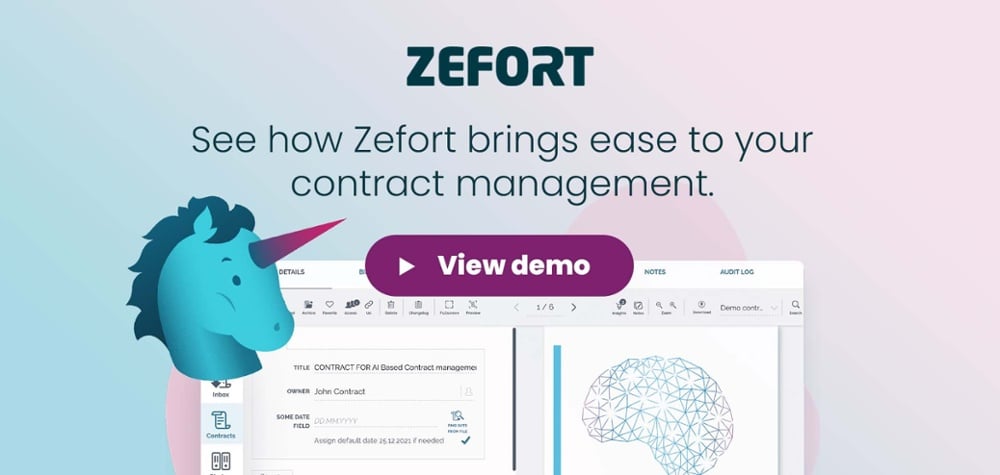Contracts are the backbone of any successful business, ensuring smooth operations, minimizing risks, and sealing the deals. However, managing contracts, from creation to execution and renewal, can be a daunting task that often consumes valuable time and resources. Fortunately, in this era of technological advancements, automating contract lifecycle management emerges as a game-changer.
By harnessing the power of automation, businesses can streamline their contract processes, improve efficiency, and unleash a myriad of benefits that ultimately pave the way for growth and success.
In this article, we delve into the advantages of adopting contract lifecycle automation, showcasing how it revolutionizes the way organizations handle their contractual obligations. So, buckle up and get ready to explore a world where contracts and technology converge to enhance productivity and propel businesses to new heights.
What is Contract Lifecycle Management (CLM)
Contract Lifecycle Management (CLM) refers to the systematic process of managing contracts from initiation to execution, and ultimately to renewal or termination. It involves every stage of a contract’s existence, including drafting, negotiation, approval, storing, execution, tracking, and reporting. CLM aims to streamline and automate these tasks to ensure efficiency, accuracy, and compliance throughout the contract lifecycle.
CLM software solutions provide organizations with a centralized platform to manage their contracts, allowing for improved visibility, control, and collaboration. This technology facilitates the organization, storage, and retrieval of contract data, documents, and associated communications, eliminating the need for manual and paper-based processes.
By implementing CLM, businesses can gain numerous benefits, such as increased efficiency and productivity, reduced risks and enhanced compliance, improved communication and collaboration, cost savings, streamlined processes, better visibility and reporting, improved negotiation and renewal processes, scalability, and adaptability.
Automating CLM allows businesses to optimize their contract management practices, saving valuable time and resources. It reduces manual errors and ensures contract terms are consistently applied and adhered to. CLM software provides features like centralized contract storage, automated alerts, workflow management, digital signatures, and analytics, empowering organizations to efficiently manage and track their contracts.
When choosing a CLM solution, businesses need to consider their specific requirements, such as integration capabilities, ease of use, flexibility, and scalability. It is important to evaluate the functionality, user experience, and support offered by different CLM providers to ensure the chosen solution aligns with the organization’s needs.
Real-world examples of successful CLM implementations can highlight the potential benefits and best practices for integrating CLM into different industries and business environments. When implementing automated CLM, organizations may need to consider potential challenges and develop a clear strategy to ensure a successful transition, user adoption, and ongoing maintenance and support.
In conclusion, CLM is a comprehensive approach to managing contracts throughout their lifecycle, enabling businesses to streamline operations, improve compliance, and optimize contract management processes. Automation through CLM software brings numerous benefits, and with the right choice of solution and implementation strategy, organizations can experience improved efficiency, reduced risks, and enhanced contract management capabilities.
The Importance of CLM
Contract Lifecycle Management is a crucial aspect of any business operation. It encompasses the entire process of creating, negotiating, managing, and analyzing contracts from start to finish. Implementing an efficient CLM system is essential for companies of all sizes, as it has numerous benefits that can positively impact the overall success and bottom line of the organization.
- Enhancing Compliance: CLM ensures that all contracts are in line with legal and regulatory requirements. By automating the process, businesses can easily monitor compliance and mitigate risks associated with non-compliant agreements.
- Optimizing Efficiency: With CLM, organizations can streamline and automate manual, time-consuming tasks such as contract creation, approval, and tracking. This frees up valuable time for employees to focus on more strategic activities and increases overall productivity.
- Reducing Risk: Manual contract management systems are prone to errors, inconsistencies, and data loss. An automated CLM solution reduces these risks by maintaining accurate records, enforcing standardized processes, and alerting users of critical dates and milestones.
- Improving Collaboration: Collaboration among internal and external stakeholders is vital for successful contract management. An automated CLM system provides a centralized digital platform that enables real-time collaboration, document sharing, and communication to ensure all parties are on the same page.
- Enhancing Visibility and Reporting: CLM allows businesses to have a comprehensive view of their contract portfolio. This visibility provides valuable insights into contract performance, obligations, and opportunities for optimization. Detailed reports and analytics further support informed decision-making.
- Enhancing Customer Satisfaction: Efficient contract management processes lead to better customer experiences. CLM automates contract renewals, amendments, and customer interactions, enabling businesses to respond swiftly to customer needs and maintain positive relationships.
- Increasing Cost Savings: Automating contract lifecycle management reduces manual errors, enhances productivity, and streamlines processes, resulting in significant cost savings. It eliminates unnecessary expenses, like missed deadlines or the need for external legal assistance.
In summary, effective CLM is essential to ensure compliance, optimize efficiency, reduce risk, foster collaboration, gain visibility, and achieve cost savings. Automating the contract lifecycle management process is a strategic investment that delivers long-term benefits and a competitive edge in today’s fast-paced business environment.
Understanding the Challenges of Manual Contract Management
- Inefficient Organization: Manual contract management relies on physical files and documents, making it difficult to quickly access and locate specific contracts when needed.
- Time-consuming Processes: Manually managing contracts involves numerous repetitive tasks such as data entry, tracking deadlines, and generating reports, which consume valuable time and effort.
- Human Error: Relying on manual processes increases the likelihood of errors such as missed deadlines, incorrect data entry, or overlooked contractual obligations.
- Lack of Visibility: Manual contract management often leads to limited visibility into contract status, making it harder to track key milestones, identify bottlenecks, or ensure compliance.
- Compliance and Legal Risks: Without a systematic approach, manual management may result in non-compliance with legal and regulatory requirements, potentially leading to legal disputes or financial penalties.
- Inadequate Collaboration: Manual contract management hampers effective collaboration between stakeholders due to limitations in sharing, consolidating, and updating contract-related information.
- Limited Analysis and Reporting: Manual processes offer limited capabilities for analyzing contract performance, identifying trends, or generating insightful reports needed for decision-making.
- Difficulty in Scaling: As the number of contracts and complexity of operations grow, manual processes become increasingly difficult to manage efficiently, hindering scalability and growth potential.
The Benefits of Automating Your Contract Lifecycle Management
Improved Efficiency and Productivity
- Automation of contract lifecycle management processes eliminates the need for manual tasks such as searching for contracts, tracking key dates, and generating renewals.
- By automating routine tasks, employees can focus on value-added activities, leading to increased productivity and efficiency in managing contracts.
- Automated CLM systems streamline workflows, allowing for faster contract creation, approval, and execution, reducing the overall contract cycle time.
- Centralized repositories enable easy access to contracts and related documents, saving time compared to manual searching through file cabinets or shared drives.
- Integration with other systems, such as CRM or ERP, eliminates redundant data entry and enhances overall operational efficiency.
- Notifications and reminders help ensure that important contract deadlines, milestones, or obligations are not missed, saving time and improving overall contract management effectiveness.
Reduced Risk and Increased Compliance
Reduced Risk: One of the key benefits of automating your contract lifecycle management is the ability to minimize risk in your contract processes. With manual contract management, there is a higher chance of overlooking critical deadlines, terms, or obligations, which can lead to costly disputes or legal issues. However, by automating CLM, you can establish alerts and reminders for important milestones, such as contract expirations or renewal dates. This proactive approach allows you to stay on top of your contracts, reducing the risk of missed deadlines or non-compliance.
Increased Compliance: Compliance with laws, regulations, and internal policies is crucial for any organization. Manual contract management makes it difficult to ensure consistent adherence to compliance standards, leading to potential legal and reputation risks. By automating CLM, you can establish standardized contract templates, clauses, and approval workflows that adhere to legal and regulatory requirements. This ensures that contracts are drafted and executed in a compliant manner, reducing the likelihood of non-compliance penalties or legal disputes.
Additionally, automated CLM systems often have built-in compliance features, such as audit trails and version control, which track all contract changes and provide a clear history of contract activity. This level of transparency allows for better auditing and regulatory reporting, further ensuring compliance.
In summary, automating your CLM processes reduces the risk of contractual errors, missed deadlines, and non-compliance. It provides a systematic and efficient approach to managing contracts, minimizing legal and reputation risks associated with manual contract management.
Cost Savings and Return on Investment
Cost savings and return on investment (ROI) are significant benefits that businesses can achieve by automating their contract lifecycle management processes.
Automating CLM helps reduce manual labor, administrative costs, and human error associated with managing contracts manually. By eliminating the need for manual data entry, searching for contracts, and tracking expiration dates, an automated CLM system saves valuable time for contract managers and legal teams. This allows them to focus on strategic activities rather than being bogged down by tedious administrative tasks.
Additionally, automation ensures improved contract compliance, reducing the risk of financial penalties and legal disputes. CLM software often includes features such as contract templates, predefined clauses, and built-in approval workflows, which promote consistency and adherence to company policies and regulatory requirements. This proactive compliance management helps mitigate risks associated with non-compliant or poorly managed contracts.
The ability to track contract milestones, such as renewal dates and key performance indicators, enhances contract visibility and enables proactive decision-making. An automated CLM system can generate real-time reports and analytics, providing valuable insights into contract performance, negotiation trends, and supplier/vendor relationships. These insights empower businesses to make data-driven decisions, identify cost-saving opportunities, and negotiate more favorable terms with their counterparts.
Implementing an automated CLM solution also leads to cost savings in terms of reduced paper usage, physical storage, and document retrieval costs. With digital contracts stored securely in a centralized repository, businesses eliminate the need for physical storage space and minimize the risk of lost or misplaced contracts. This accessibility and organization contribute to faster contract processing and accelerated revenue recognition.
Return on investment (ROI) from automated CLM transcends beyond immediate cost savings. By streamlining contract processes, businesses can accelerate contract cycles, resulting in faster time to revenue. The increased efficiency and accuracy of CLM automation also lead to improved supplier/vendor relationships, ensuring favorable contract terms and reducing the risk of business disruptions.
In summary, the cost savings and return on investment achieved by automating contract lifecycle management provide organizations with increased efficiency, reduced risks, improved compliance, and enhanced contract visibility. These benefits not only save time and resources but also contribute to the overall success and profitability of businesses.
Streamlined Contract Processes
Streamlined Contract Processes refers to the optimization and simplification of various stages involved in contract management, achieved through automation. This allows for smoother workflow, improved efficiency, and reduced manual errors. Streamlining contract processes entails:
- Centralized Repository: A single, secure digital platform to store all contracts, enabling easy retrieval and access.
- Automated Workflows: Defined processes and notifications to automate tasks like contract creation, review, approval, and execution, ensuring consistent and timely completion.
- Collaboration and Tracking: Real-time collaboration and communication tools facilitate stakeholders’ collaboration, enabling them to provide feedback, make edits, and track changes efficiently.
- Version Control: Automatic versioning ensures that all changes are properly documented and tracked, allowing users to access previous versions if needed.
- Contract Renewal Reminders: Automatic notifications for contract expiration dates, prompting timely renewal actions and preventing overlooked deadlines.
- Integration with E-Signature Tools: Seamless integration with electronic signature software reduces time spent on manual signatures and expedites contract execution.
- Audit Trails: Comprehensive logs of all contract activities, including edits, approvals, and access history, providing transparency and ensuring compliance.
- Workflow Analytics: Data-driven insights on contract progress, bottlenecks, and cycle times, enabling organizations to identify areas for improvement and optimize their processes.
- Real-Time Reports and Dashboards: Customizable dashboards and reports that provide a comprehensive overview of contract status, key metrics, and performance indicators.
- Contract Analytics and Clause Management: Advanced analytics capabilities to gain insights into contract performance, risks, and opportunities.
Through streamlined contract processes, businesses can reduce administrative burdens, enhance accuracy, decrease bottlenecks, and ensure better visibility and control over contractual obligations. Ultimately, this leads to increased efficiency, compliance, and improved overall contract management.
Improved Contract Visibility and Reporting
- CLM software provides a centralized repository for storing all contracts, making it easy to access and view contracts at any time.
- With automated CLM, contracts can be categorized, tagged, and organized, allowing for quick and efficient retrieval and reference.
- CLM systems offer customizable reporting features that allow users to generate detailed reports on contract status, key dates, obligations, and performance metrics.
- Real-time visibility into contract data enables businesses to identify trends, track contract lifecycles, and make data-driven decisions.
- Improved contract visibility and reporting minimize contract bottlenecks, ensuring that important contract milestones and deadlines are not overlooked.
- With better visibility, businesses can also catch potential risks and issues early on, preventing potential legal disputes and financial loss.
Key Features and Functionalities of Automated CLM Systems
- Centralized Repository: Automated CLM systems provide a centralized repository to store all contract documents, making it easy to access and search for specific contracts or clauses.
- Workflow Automation: Automated CLM systems streamline the contract approval process by automating workflows. These systems can automatically route contracts for review, approval, and signature, ensuring that all necessary stakeholders are involved and reducing delays.
- Contract Authoring and Collaboration: These systems enable multiple users to collaborate on contract drafting. They offer features such as version control, redlining, and comments, allowing for efficient collaboration and seamless communication among teams.
- Contract Tracking and Notifications: Automated CLM systems provide real-time tracking of contract status, enabling users to monitor contract milestones, upcoming deadlines, and renewals. They also send automated notifications to ensure timely action on important contract-related tasks.
- Intelligent Analytics and Reporting: CLM systems offer advanced analytics and reporting capabilities, providing valuable insights into contract performance, risk assessment, and compliance. These features help businesses make data-driven decisions and identify areas for improvement.
- Integration with Other Systems: Automated CLM systems can integrate with other business software applications such as CRM or ERP systems, allowing for seamless data exchange and enhancing overall operational efficiency.
- Security and Compliance: CLM systems prioritize data security and compliance with features like user access controls, encryption, audit trails, and compliance tracking. These ensure that confidential contract information remains protected and that businesses remain compliant with regulatory requirements.
- Contract Renewals and Expirations Management: Automated CLM systems send reminders and notifications about upcoming contract renewals or expirations, reducing the risk of missed opportunities or unauthorized renewals.
- Customization and Scalability: These systems offer customization options to align with unique business requirements, allowing users to tailor the system according to their specific needs. Moreover, they are scalable and can accommodate growing contract volumes and diverse contract types.
By leveraging the key features and functionalities of automated CLM systems, businesses can streamline their contract processes, mitigate risks, enhance collaboration, and ultimately improve overall contract management efficiency.
How to Choose the Right CLM Solution for Your Business
Choosing the right Contract Lifecycle Management solution for your business can be a crucial decision that impacts efficiency, productivity, and overall contract management success. Here are some key considerations to keep in mind when selecting a CLM solution:
- Identify Your Needs: Assess your specific contract management requirements, such as document storage, contract creation, collaboration features, reporting capabilities, and integrations with other systems.
- Scalability and Customization: Ensure that the CLM solution can adapt to your business’s evolving needs and supports customization options to align with your unique workflows and processes.
- Usability and User Interface: Look for a user-friendly interface that minimizes the learning curve, as intuitive software will encourage employee adoption and maximize productivity.
- Integration Capabilities: Consider the CLM solution’s ability to integrate with your existing systems (e.g., CRM, ERP) to enable seamless data sharing and streamline operations.
- Security and Compliance: Prioritize solutions that offer robust data security measures, including encryption, access controls, audit trails, and compliance with relevant regulations like GDPR or HIPAA.
- Vendor Reputation and Support: Research the vendor’s reputation, customer reviews, and track record. Ensure they provide ongoing customer support, including training resources and responsive assistance.
- Cost and Return on Investment: Evaluate the pricing structure, implementation costs, ongoing maintenance fees, and potential ROI. Calculate the expected benefits against the solution’s expenses to make an informed decision.
- Implementation Process: Understand the implementation timeline, requirements, potential disruptiveness, and resource allocation needed to deploy the CLM solution successfully.
- Mobile Access: If mobility is crucial for your organization, verify that the CLM solution offers mobile compatibility to allow users to access and manage contracts from anywhere, improving flexibility and responsiveness.
- Future-Proofing: Consider how the CLM solution will support your long-term goals and any emerging technologies, such as artificial intelligence or machine learning, that may benefit contract management.
By carefully considering these factors, you can select a CLM solution that aligns with your business requirements, enhances contract management efficiency, and provides a solid foundation for improved contract lifecycle management.
Tips for Implementing Automated CLM
- Identify your organizational needs and goals: Before implementing an automated Contract Lifecycle Management solution, clearly define your organization’s specific needs and objectives. This will help you choose the right CLM system that aligns with your requirements.
- Engage stakeholders: Involve key stakeholders from different departments within your organization, such as legal, procurement, and finance, in the implementation process. Their input and collaboration will ensure that the CLM system caters to their needs and improves overall efficiency.
- Define processes and workflows: Map out your existing contract processes and workflows, and identify areas that can be automated. By defining clear processes, you can streamline contract creation, negotiation, approval, and renewal, ensuring that everyone understands their roles and responsibilities.
- Customize and configure the CLM system: Tailor the CLM system to fit your specific business needs. Customize fields, templates, and workflows to match your organization’s requirements. Configuring the system will help maximize its efficiency and usability for your team.
- Provide training and support: Proper training is essential for successful CLM implementation. Ensure that your team understands how to use the new automated system effectively. Offer ongoing support and resources to address any questions or issues that may arise during the transition period.
- Ensure data accuracy and migration: Before migrating your existing contracts and data to the new CLM system, conduct a thorough review to ensure accuracy and completeness. Clean and validate your data to avoid any discrepancies or errors that could affect future operations.
- Foster user adoption: Encourage your team to embrace the automated CLM system by highlighting the benefits it brings, such as time savings, improved accuracy, and reduced risk. Address any concerns or resistance, and provide continuous reinforcement to ensure adoption and long-term success.
- Monitor and evaluate performance: Once the CLM system is in place, regularly monitor its performance and gather feedback from users. This will help identify areas for improvement, address any issues that may arise, and ensure that the system continues to deliver the expected benefits.
- Stay updated and evolve: Keep up with the latest technological advancements and enhancements in CLM systems.
Periodically review and upgrade your CLM solution to take advantage of new features or functionalities that can further optimize your contract management processes.
By following these tips, you can smoothly implement an automated CLM system to streamline your contract processes, improve efficiency, and achieve better contract lifecycle management outcomes.
Wrapping things up
Automating your contract lifecycle management can bring a host of benefits to your organization. By implementing this technology, you can streamline your contract processes, reduce manual errors, and increase efficiency. Automated CLM allows for centralized storage and easy retrieval of contracts, saving time and effort. Improved visibility and tracking of key contract milestones help to avoid missed deadlines and penalties.
Additionally, automation enables efficient collaboration among teams, enhancing productivity and driving faster decision-making. By eliminating the need for manual review and approval processes, automation can reduce cycle times and accelerate contract execution. Furthermore, automating CLM ensures better compliance with regulatory requirements and minimizes legal risks.
Overall, by embracing automation in your contract management, you can achieve operational excellence, cost savings, and improved contract outcomes.






